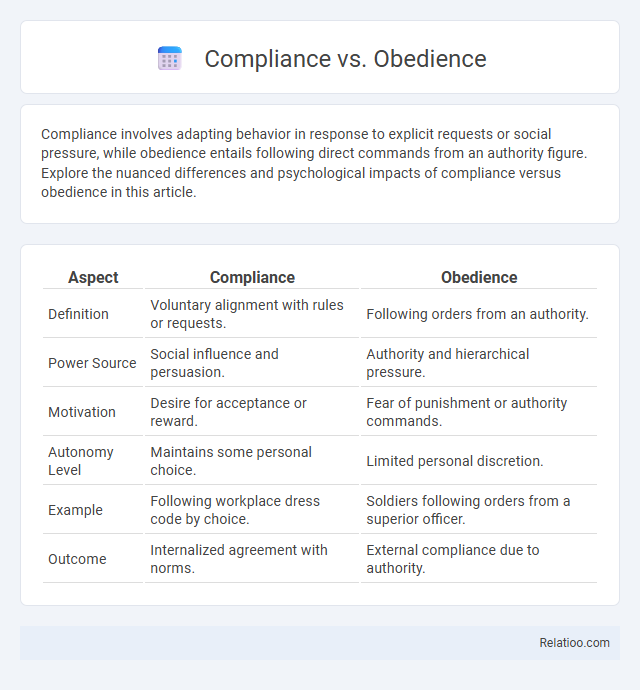Compliance involves adapting behavior in response to explicit requests or social pressure, while obedience entails following direct commands from an authority figure. Explore the nuanced differences and psychological impacts of compliance versus obedience in this article.
Table of Comparison
| Aspect | Compliance | Obedience |
|---|---|---|
| Definition | Voluntary alignment with rules or requests. | Following orders from an authority. |
| Power Source | Social influence and persuasion. | Authority and hierarchical pressure. |
| Motivation | Desire for acceptance or reward. | Fear of punishment or authority commands. |
| Autonomy Level | Maintains some personal choice. | Limited personal discretion. |
| Example | Following workplace dress code by choice. | Soldiers following orders from a superior officer. |
| Outcome | Internalized agreement with norms. | External compliance due to authority. |
Understanding Compliance and Obedience
Understanding compliance involves recognizing it as a behavioral response to explicit requests or social norms, where individuals conform without internal agreement, focusing on external influences and social pressure. Obedience differs as it entails following directives from authority figures, often driven by perceived legitimacy and hierarchical structures, emphasizing submission to power. Both concepts highlight variations in social influence mechanisms, with compliance rooted in peer or societal expectations and obedience anchored in authoritative command.
Key Differences Between Compliance and Obedience
Compliance involves following rules or requests due to external pressure or incentives, while obedience is characterized by submitting to authority figures regardless of personal beliefs. Compliance often occurs in peer-driven situations, whereas obedience is more hierarchical, requiring adherence to commands from recognized authority. Understanding these distinctions helps you navigate social dynamics effectively, as compliance reflects voluntary agreement and obedience implies directive control.
Psychological Foundations of Compliance
Psychological foundations of compliance involve social influence mechanisms such as authority, social proof, and the desire for approval, which drive individuals to conform to rules or requests without necessarily altering personal beliefs. Compliance differs from obedience, which entails following direct commands from an authority figure, often studied through classic experiments like Milgram's obedience study. Understanding these psychological drivers is essential for distinguishing compliance's voluntary, often subtle social compliance from more overt obedience or outright conformity.
Mechanisms Driving Obedience
Mechanisms driving obedience include authority recognition, social pressure, and psychological conditioning, which compel individuals to follow directives even against personal judgments. Your behavior can be influenced by hierarchical structures where obedience ensures social order and compliance results from perceived expectations or rules. Understanding these mechanisms differentiates obedience, characterized by direct command adherence, from compliance and general conformity.
Influential Experiments: Milgram and Asch
Milgram's experiment highlighted obedience by demonstrating how individuals comply with authority figures despite ethical conflicts, while Asch's conformity studies revealed how social pressure influences compliance with group norms even against personal judgment. These influential experiments underscore the psychological mechanisms behind how Your behavior can be shaped by authority and peer influence. Understanding the distinctions between compliance, obedience, and conformity is essential for analyzing social dynamics in various contexts.
Social and Cultural Factors at Play
Social and cultural factors significantly influence the distinctions between compliance, obedience, and conformity, shaping individuals' responses to authority and group norms. Compliance often arises from explicit requests within culturally defined power dynamics, while obedience involves adherence to direct commands typically embedded in hierarchical social structures. Conformity reflects the internalization of cultural norms and social expectations, driven by the desire for social acceptance and cohesion within a particular community or society.
Real-World Examples of Compliance
Compliance involves following rules or requests typically to gain rewards or avoid punishment, as seen when employees adhere to workplace safety protocols despite personal inconvenience. Obedience requires submitting to authority figures, like when civilians comply with police orders during traffic stops. Your understanding of compliance deepens by examining real-world examples such as consumers following GDPR regulations by consenting to cookie policies on websites to protect personal data.
Real-World Cases of Obedience
Real-world cases of obedience reveal how individuals follow orders from authority figures, even when actions conflict with personal morals, as demonstrated in the Milgram experiment and the Stanford prison study. Compliance involves conforming to requests or rules for social acceptance, while obedience requires direct command adherence, impacting organizational behavior and legal accountability. Your understanding of these distinctions can enhance ethical decision-making and leadership strategies in professional environments.
Ethical Implications in Society
Compliance, obedience, and conformity each carry distinct ethical implications in society, influencing individual autonomy and moral responsibility. Compliance involves adhering to rules or standards often set by external authorities, raising concerns about ethical awareness and informed consent. Obedience, typically to direct commands from authority figures, can challenge personal moral judgment, while conformity reflects social pressure to align behaviors with group norms, impacting ethical decision-making and social cohesion.
Fostering Healthy Autonomy
Fostering healthy autonomy requires understanding the nuanced differences between compliance, obedience, and genuine adherence to guidelines. Compliance involves following rules to avoid punishment, obedience demands unquestioning submission to authority, while true compliance aligns personal values with external expectations, promoting intrinsic motivation. You can encourage autonomy by creating environments where individuals internalize rules, fostering ownership and responsible decision-making rather than mere adherence.

Infographic: Compliance vs Obedience
 relatioo.com
relatioo.com